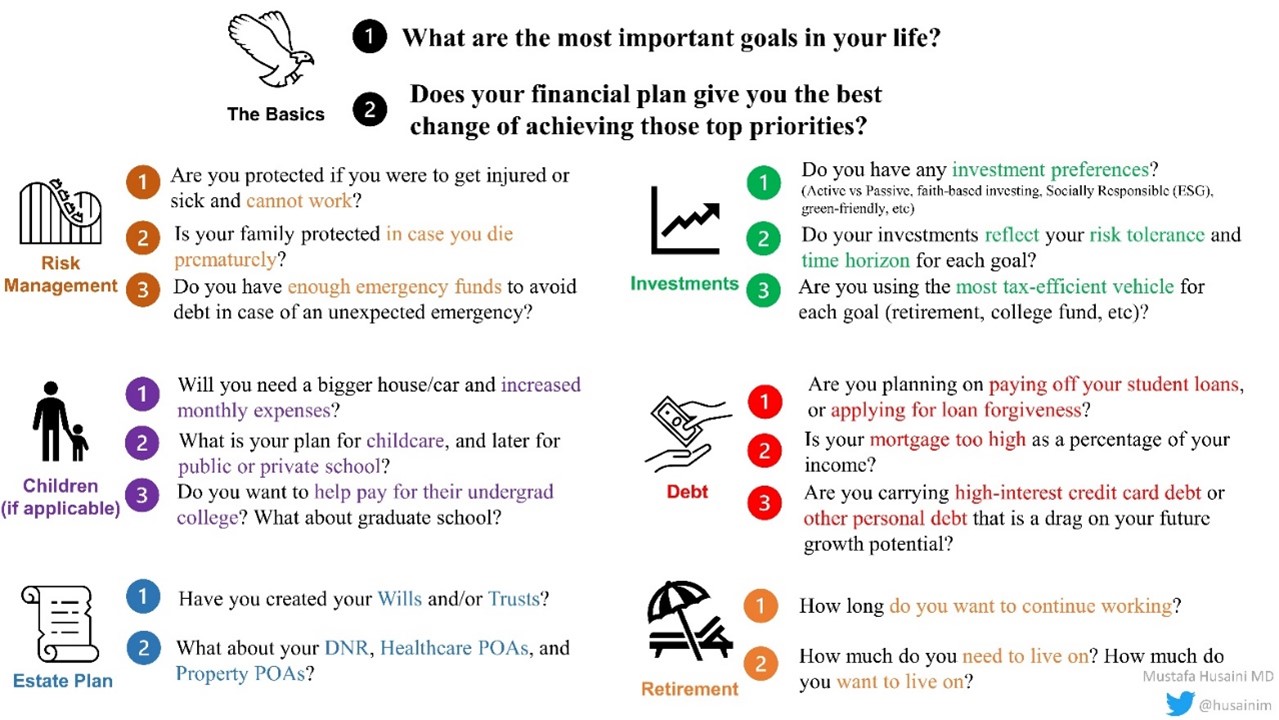Part 4: Creating a Financial Plan

In my first and second articles, I addressed the big picture of how to think about your finances in order to create a sound financial plan. In my third article, I went over the nuts and bolts of various financial accounts. For part 4 of this financial series, I will put all of this together to help you construct a basic financial plan.
First, it is important to review why you should create one. A financial plan will provide the foundation for future decisions. It also helps to create a roadmap to navigate calm waters as well as market volatility. A financial plan can also reduce your expenses and tax burden, increase your long-term returns and net worth, reduce risk, minimize inefficiencies and panic selling and help you plan for items you may not have considered previously.
Where do I start?
The first step in your financial plan is to know your assets and liabilities. The next step is creating a plan to increase your assets and decrease your liabilities. If this sounds simple, that's because it is.
When people start thinking about their personal finances and their financial plan, they often consider these common questions (see Figure 1).
Now, think about these questions in the context of your financial goals. Remember, money is only the lubricant that will allow you to achieve your goals. Based on each goal, consider your investing horizon, risk tolerance, and specificity for that goal with respect to timing, amount, and investment strategies. For example, I want to retire at 60 with $120,000 of annual income. As this is a long-term goal, my risk tolerance is high. I plan on achieving this through saving 20% of my gross income, with a majority invested in index funds.
You will have different goals, appetite for risk, and fund preferences, so it is important to customize this for yourself.
Where does the money go?
Once your financial goals are specified, the next step is to determine your approach to saving for these goals. There are numerous approaches which can range from using labeled envelopes with cash, tracking everyday expenses with an Excel sheet or other online programs (Mint, Personal Capital, etc.), or even removing a fixed amount from each paycheck to force yourself to save. Here is a quick example of the last method:
Savings: 20% of gross income
Taxes: 30% of gross income (Other factors to consider: Spouse income, location, other investments, etc.)
Needs: 20-40% of gross income (Housing, childcare, food, clothing, etc.)
Wants: Whatever is left (Luxury items, entertainment, travel, etc.)
Based on your various financial goals, the status of your emergency fund, and your unique situation, these ratios can be adjusted. But your savings rate should be non-negotiable.
A common phrase in the financial independence community is to "pay yourself first." This means that your 30-year-old self should pay your 70-year-old self before paying all your other bills. A great way to achieve this is by maximizing your contributions to your tax-advantaged accounts (employer retirement accounts, IRAs, and HSA).
Where and how can I invest?
A common method of investing, popularized by John Bogle, is with index funds. An index fund is a portfolio of investments that are constructed to track a financial market index, such as the DOW Jones industrial, the S&P 500, or even the health care sector. In contrast to actively managed funds, which typically charge a higher expense ratio for active trading and portfolio management, index funds use a passive-investing strategy by owning the entire index. As a result, they often have low expense ratios and minimal turnover. By encompassing an entire market, diversification is built in, and transaction fees are minimized. Of course, passive investing is not for everyone, and some downsides include the inability to customize your holdings (over or under-weighting certain sectors, companies, or industries) and never being able to beat the market.
As part of your diversification, it is prudent to have different assets within your investment portfolio. For each financial goal, be mindful of your investing time horizon and risk tolerance as you determine your asset allocation. If you have a short-term investing goal, such as saving for your first house, then you likely have a lower risk tolerance and will want to allocate to assets accordingly. For longer-term investing, such as retirement, your risk tolerance will change over the years and as a result, your asset allocation should reflect that.
Next to come
Congratulations! You just finished this core introduction into your financial fellowship. Tune in later this year as our colleagues cover more topics that we think will be helpful as you continue to explore your financial independence.
Homework
- Create your financial plan, independently or with the assistance of a financial planner.
- Explore various online calculators & tools to assist you in this process (Fidelity, Personal Capital, etc).

This article was authored by Mustafa Husaini MD, FACC,with input by Rahul Chhana, MD a fellow at Washington University in St. Louis, and Husaini’s personal financial adviser, Mohammed Esmail, CFP
This content was developed independently from the content developed for ACC.org. This content was not reviewed by the American College of Cardiology (ACC) for medical accuracy and the content is provided on an "as is" basis. Inclusion on ACC.org does not constitute a guarantee or endorsement by the ACC and ACC makes no warranty that the content is accurate, complete or error-free. The content is not a substitute for personalized medical advice and is not intended to be used as the sole basis for making individualized medical or health-related decisions. Statements or opinions expressed in this content reflect the views of the authors and do not reflect the official policy of ACC.

